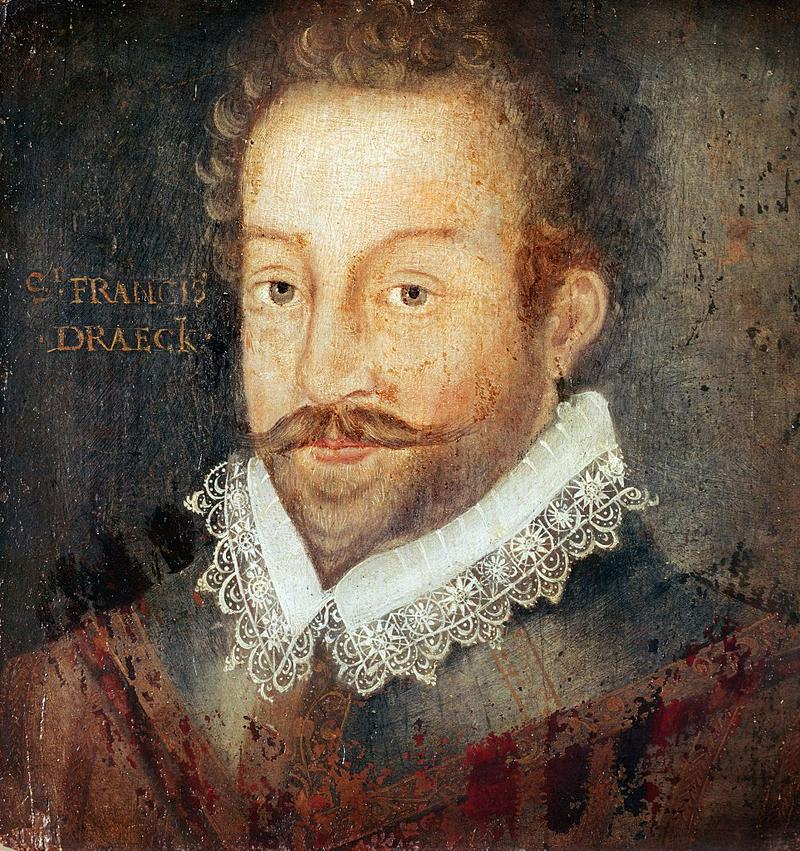Sir Francis Drake: Pirate, Slave Trader, Discoverer Of The World
By | September 22, 2020

On September 26, 1580, after three long years at sea, Sir Francis Drake became the first Englishman to circumnavigate the globe. You probably learned about Drake, who was knighted by the Queen of England for his heroism and bravery, and his adventures at sea and in battle with the Spanish Armada in school, but what's the real story behind this not-pirate?

The Sailor's Apprentice
Francis Drake's exact date of birth is unrecorded, but it was likely around 1540. We do know that he was the oldest child born to Edmund Drake and his wife, Mary Wyllwave. The Drakes, their 12 sons, and an unrecorded number of daughters lived on the vast estate of the Second Earl of Bedford and worked the land as tenant farmers.
When Drake was a young teen, his father arranged for him an apprenticeship with a merchant sailor. He turned out to be a natural on the high seas, and soon enough, distant relatives from the Hawkins privateering family reached out to form an alliance. Privateers were basically pirates, but they were sanctioned by the crown and paid it a percentage of their spoils, so it was a technically legal (if not entirely ethical) enterprise. Drake showed no reservations, though, joining his cousins in loitering in the French shipping lanes and plundering merchant ships.
Drake didn't have a lot of reservations in general. By the early 1560s, he was given command of his own ship, so he took it to Africa to kidnap some locals to be sold as slaves in the Spanish colonies of the New World. This was super illegal under Spanish law, so Drake spent some time on the run from their government and claimed it left him with a burning hatred for Spain. It kind of seems like he brought that on himself, but whatever.

The Favorite
Francis Drake was a favorite of Queen Elizabeth I. She granted him his own privateer commission in 1572, which was "essentially a license to plunder any property belonging to King Philip II of Spain," an offer he accepted with gusto. Five years later, she commissioned Drake to embark upon a voyage of discovery along the Pacific Coast of South America, which tells you how pleased she was with his work. But he wasn't just brutal with Spain: Drake clashed with one of the naval officers Lizzy lent him, Thomas Doughty, so he accused him of plotting mutiny, for which he was swiftly convicted in a hasty trial and executed by beheading.
You'd think that might put a damper on his relationship with the Queen, but soon after, Drake and his fleet sailed through the Strait of Magellan into the Pacific Ocean and claimed California for her, which presumably satisfied her. Queens love states. Historians speculate, however, that Drake covered more territory that he said. Some people believe that he sailed into what is now Oregon and Washington or even farther, to the coast of British Columbia and Alaska. From there, Drake sailed across the open Pacific Ocean, through the Indian Ocean, and around the Cape of Good Hope in Africa on his way back to England, making him the second person to sail around the globe. His achievement earned him a knighthood.

Battling The Spanish Armada
Political tensions between England and Spain grew to a boiling point in the mid-1580s, and Drake certainly hadn't helped. Queen Elizabeth I asked Drake to attack Spanish seaside communities in both Europe and South America to loot their riches and lower their morale, which angered King Philip so much that he commissioned the construction of a huge fleet of warships and set sail for England. Just before the Spanish Armada left for England, Drake launched a preemptive strike and destroyed 30 of its ships. Still, it was not enough to stop the Spaniards.
The Queen named Drake the new vice admiral of the English Navy in 1588. Soon after, 130 vessels of the Spanish Armada sailed into the English Channel while several other Spanish ships anchored off the coast of Calais, France, just waiting for more Spanish soldiers to join them. On the evening of July 27, Drake arranged for fire ships to sail right into the Spanish Armada. Alarmed, the sea captains pulled up their anchors to avoid the fiery ships, and strong winds scattered the Spanish ships all over the place. The English vessels easily overtook them, and thousands of Spanish soldiers drowned in the aftermath, while the ones who managed to swim to shore were captured and executed.

The Inner Life Of Francis Drake
Francis Drake spent much of his time at sea, but he did manage to get married twice, first to Mary Newman for 12 years, until her death, and then to Elizabeth Sydenham. He spent very little time with either of his wives and never fathered any children, but he used some of his pillaging riches to purchase a great estate in Devon, England, which he called Buckland Abbey. The estate is still standing and now open to the public.
Drake continued to sail until 1595, when he was once again sent to Panama to seize assets belonging to Spain and contracted dysentery, a common yet deadly disease. He spiked a fever, and on January 28, 1596, he succumbed to his illness. His body was placed in a lead coffin and tossed into the sea near Portobelo, Panama, where people still search for it to this day.

